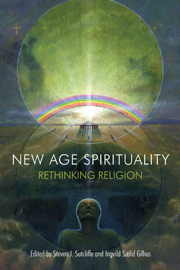Book contents
- Frontmatter
- Contents
- Introduction: “All mixed up” – thinking about religion in relation to New Age spiritualities
- Part I Rethinking New Age spiritualities
- Part II Comparing New Age beliefs and practices
- 6 Narrow New Age and broad spirituality: a comprehensive schema and a comparative analysis
- 7 Dolphins and other humans: New Age identities in comparative perspective
- 8 New Age, Sami shamanism and indigenous spirituality
- 9 The holistic milieu in context: between traditional Christianity and folk religiosity
- 10 New Age and the spirit of capitalism: energy as cognitive currency
- Part III Putting new spiritual practices to work
- Conclusion: New Age spiritualities – “good to think” in the study of religion
- Contributors
- Further reading
- Bibliography
- Index
7 - Dolphins and other humans: New Age identities in comparative perspective
from Part II - Comparing New Age beliefs and practices
- Frontmatter
- Contents
- Introduction: “All mixed up” – thinking about religion in relation to New Age spiritualities
- Part I Rethinking New Age spiritualities
- Part II Comparing New Age beliefs and practices
- 6 Narrow New Age and broad spirituality: a comprehensive schema and a comparative analysis
- 7 Dolphins and other humans: New Age identities in comparative perspective
- 8 New Age, Sami shamanism and indigenous spirituality
- 9 The holistic milieu in context: between traditional Christianity and folk religiosity
- 10 New Age and the spirit of capitalism: energy as cognitive currency
- Part III Putting new spiritual practices to work
- Conclusion: New Age spiritualities – “good to think” in the study of religion
- Contributors
- Further reading
- Bibliography
- Index
Summary
Present-day popular religion offers a variety of expressions and ways that are typical to the open minds and loose structures of devoted New Age entrepreneurs. Scholars of New Age agree on most characteristics: syncretistic belief systems, lack of institutionalization, counter-cultural engagements, experiential disciplines of esoteric and occult kinds, links to popular culture in general, scientistic perspectives, emphasis on individual experience and transformation, and a high degree of individualism – to mention the most obvious. These phenomena are often understood to be elements in a particularly modern or even postmodern reality.
On that account it will come as no surprise to the reader that an obliging and embracing woman in her early thirties, with no hesitation, may remind you that she is in fact a dolphin. I am referring to an actual event during a so-called Body, Mind, Spirit bazaar in Copenhagen, Denmark, in 2004, which I attended for fieldwork purposes. The woman offered her services as a clairvoyant with the following credentials on full display: “Formerly incarnated on Venus”. Lecturing me about life on that distant planet, and blaming me for my rational and definitely “non-spiritual attitude”, she triumphantly said, taking her hands to her breast: “Mind you, I'm a dolphin!” Compared with the average self perception of Euroamerican females in their thirties, this is a remarkable statement, and our immediate analysis is simple: Her self-perception is best interpreted as a detraditionalized notion, driven by a mythology born of a fragmented, individualized, experimenting culture void of tradition.
- Type
- Chapter
- Information
- New Age SpiritualityRethinking Religion, pp. 117 - 131Publisher: Acumen PublishingPrint publication year: 2013



